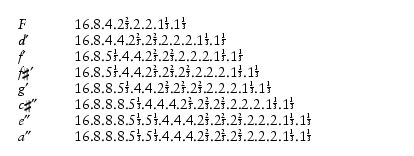
(Ger.; Dut. blokwerk).
The undivided principal chorus of the medieval organ (see Organ, esp. §IV, based upon a ‘double Principal’ (two open unison Principals/Diapasons) without any ranks separated off as individual stops. The term itself may be 18th-century (Utrecht organ documents, 1731), although according to J. Hess (1807) it was used by ‘old builders’. At Reims (1487) it is known only that the organ had 2000 pipes, at Amiens (1422) that the four-octave keyboard began at 19 ranks and ended at 91, at Dijon (c1350) that those ranks were made up of Principals, Octaves, Super-octaves and Twelfths. As well as 8', the Blockwerk could be based on open 4' (Leuven, 1445), open 16' (Delft, 1458) or deeper, according to the pitch and key compass. The 1480 Blockwerk now in Middelburg, Netherlands, had a probable disposition of:

The most useful description of the sound of a Blockwerk is Praetorius's (Syntagma musicum, ii (1618, 2/1619), p.99) of that at Halberstadt (1357–61):
The large Praestants and the low manual compass, which does not rise high enough for lightness of sound, caused together a deep coarse rumbling as of a dreadful distant thunder, while the many-rank Mixture [i.e. undivided chorus] gave an exceeding shrillness, strong, loud and powerful.
The Blockwerk belonged essentially to (a) the fixed church organ (as distinct from positives, etc.) and (b) northern Europe. Organs in Bordeaux, Lombardy and Tuscany already had mostly single, separable ranks by c1500 (S Giustina, Padua, 1493, organ of 16.8.51/3.4.22/3.2.11/3.1). A full account of the history of the Blockwerk is given in R. Quoika: Vom Blockwerk zur Registerorgel: zur Geschichte der Orgelgotik, 1200–1520 (Kassel, 1996).
PETER WILLIAMS/BARBARA OWEN